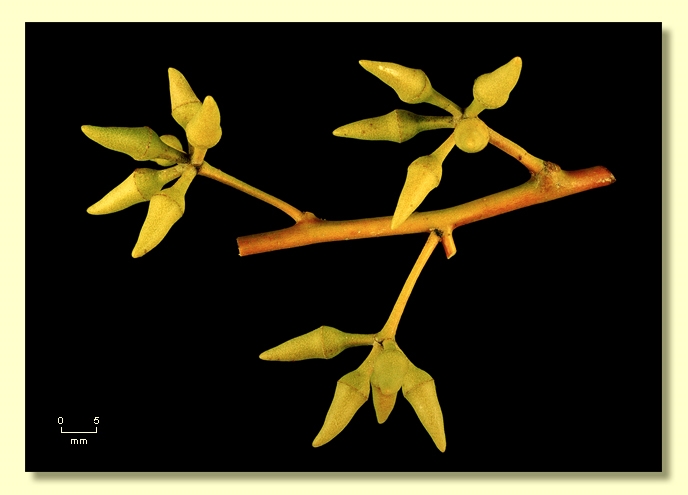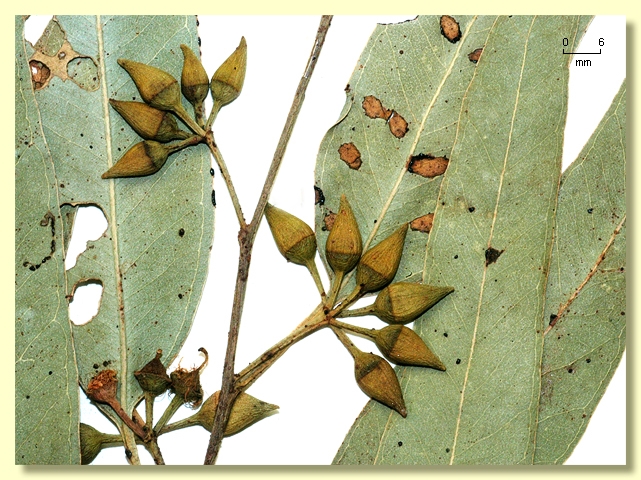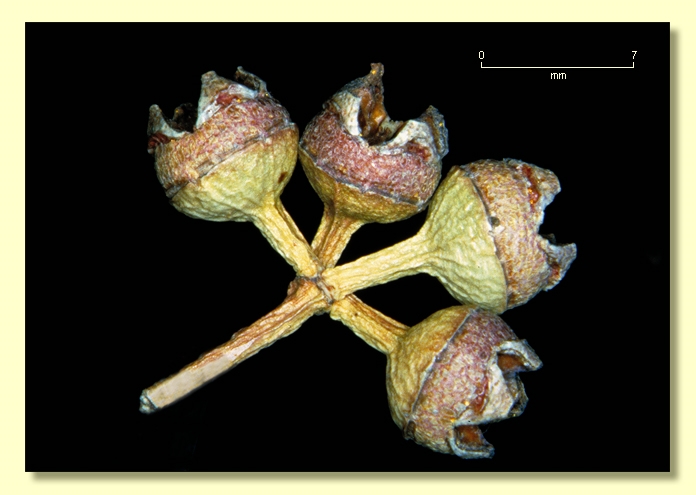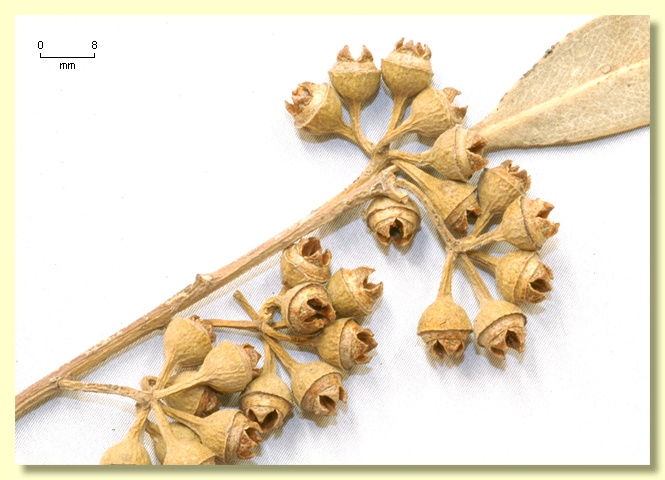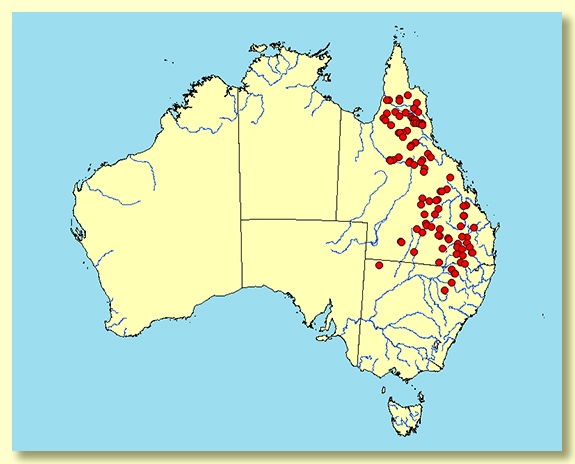Euclid - Online edition
Eucalyptus camaldulensis subsp. acuta
Eucalyptus | Symphyomyrtus | Exsertaria | Rostratae
Eucalyptus camaldulensis subsp. acuta Brooker & M.W. McDonald in McDonald et al., Australian Systematic Botany 22: 270 (2009).
T: Maranoa River at Forest vale, ~ 63 km N of Mitchell, on road to Injune, Queensland, 27 July 2003, M.W. McDonald 3182 & P.A. Butcher; holo: CANB; iso: BRI, MEL.
E. acuminata Hook. In T.L.Mitchell, J. Exped. Trop. Australia 390 (1848); E. rostrata var. acuminata (Hook.) Maiden, Crit. Revis. Eucalyptus 4: 67 (1917); E. camaldulensis var. acuminata (Hook.) Blakely, Key Eucalypts 135 (1934). T: Moonie Ck or R., [Qld], 20 Nov. 1846, T.L.Mitchell 435; iso: CGE, NSW.
Tree to 30 m tall. Lignotuber present or absent.
Bark smooth throughout or with some persistent flakes of rough bark on lower trunk; smooth bark predominantly white, cream and pale grey but with pink or brown patches; branchlets rarely glaucous.
Juvenile growth (coppice or field seedlings to 50 cm): stems square in cross-section, growing tips and stems glaucous; juvenile leaves always petiolate, opposite for a few nodes then becoming alternate, ovate or broadly lanceolate, 6-25 cm long, 3-9 cm wide, often with undulate margin, blue-green or grey-green.
Adult leaves alternate, petiole 1-3.1 cm long; blade lanceolate to falcate, 9-29 cm long, 1.4-4 cm wide, base tapering to petiole, concolorous, dull, green or blue-green, rarely glaucous, side-veins greater than 45° to midrib, venation densely reticulate, intramarginal vein parallel to and well removed from margin, oil glands numerous, island, rarely obscure.
Inflorescence axillary unbranched, peduncles 0.6-2 cm long, buds 7 per umbel, pedicellate (pedicels 0.2–0.9 cm long). Mature buds more or less elongated ovoid (0.6–0.9 cm long, 0.4–0.6 cm wide), green to yellow or rarely glaucous, smooth, scar present (outer operculum shed early), inner operculum acutely conical (operculum 0.6–0.9 cm long), stamens erect with anthers facing ovary roof and style, anthers cuboid to oblong, versatile, dorsifixed, dehiscing by longitudinal slits (non-confluent), style long, stigma blunt, locules (3)4-5 each with 6 vertical ovule rows on the placenta. Flowers white.
Fruit pedicellate (pedicels 0.2–1.1 cm long), hemispherical, 0.2–0.4(0.6) cm long, 0.4–0.9 cm wide, disc raised and convex, oblique or almost vertical, valves (3)4-5, strongly exserted.
Seeds yellow to yellow-brown, smooth, glossy, 0.8–1.5 mm long, cuboid or pyramidal, hilum terminal.
Cultivated seedlings (measured at node 10): cotyledons oblong to reniform; stems square in cross-section, at least slightly glaucous; leaves always petiolate, opposite for 4 to 9 nodes then alternate, ovate to broadly lanceolate, 9–16 cm long, 2.8-5 cm wide, margins often undulate, dull, green to blue-green or glaucous.
Flowering has been recorded in August, September, October and November.
Eucalyptus camaldulensis is the most widespread species of eucalypt in Australia, occurring in every mainland State. It is notably a smooth-barked tree along streams whether of permanent, seasonal or intermittent flow. The species over its whole distribution is distinguished by the seeds which are cuboid-pyramidal and have two seedcoats, the outer being yellow to brownish yellow and glossy. (All other red gum species have seeds with a single, rough-textured dark brown to black seedcoat.)
Across the entire range of E. camaldulensis the shape of the operculum found on the mature buds is highly variable. This character, together with the arrangement of stamens inside the mature bud, the size, shape and waxiness of the juvenile leaves and the venation density visible in fresh adult leaves, has been used to divide the species into seven different subspecies (see McDonald et al. (2009)). The seven subspecies have reasonably discrete geographic distributions as outlined below.
Eucalyptus camaldulensis is classified in subgenus Symphyomyrtus section Exsetaria (the red gums) because it has small reniform-oblong cotyledons, seedling leaves petiolate and soon becoming alternate on the stem, adult leaves concolorous, axillary inflorescences a simple umbel, the buds have two opercula with the outer sepaline operculum being shed early in development, fruit with raised disc and exserted valves and seeds cuboid-pyramidal with a terminal hilum. The presence of two seedcoats at seed maturity distinguish the species further placing it as the sole species in series Rostratae.
E. camaldulensis subsp. camaldulensis
This is the form of the species found in temperate south-eastern Australia and dominates the Murray-Darling river system. In Queensland it occurs in the Darling Downs and Maranoa pastoral regions, as far north as the Condamine River from Warwick in the east as far west as the Balonne (Culgoa) River but not as far as the Warrego River. Through New South Wales it occurs on all east rising tributaries of the Darling River, and the Darling itself, and streams flowing through the Riverine Plain to join the Murray River. Outlier populations occur in the easterly flowing Hunter River catchment at Aberdeen and near Maitland. Its upper altitudinal limit is in the Yass - Canberra area (ca 500 m. asl). In South Australia it occurs along the Murray River and also on the lower Eyre Peninsula, Kangaroo Island, Yorke Peninsula, and the south-east of the State. In Victoria it is the only subspecies found and occurs on all lowland streams and fresh-water lakes, from the Glenelg River system and associated plains in the south-west, to streams as far east as Sale in Gippsland, and, north of the Great Dividing Range, on many streams flowing to join the Murray River, or, in the mallee areas, on rivers and creeks terminating in lakes and isolated soaks.
Subsp. camaldulensis is distinguished from all other subspecies by the opercula, which are strongly beaked, stamens which are inflexed or irregularly flexed in bud, and the non-glaucous, green, narrowly lanceolate juvenile leaves.
At Mount McIntyre, north-west of Mount Gambier, South Australia, a relatively robust-fruited red gum was described as Eucalyptus mcintyrensis in 1922, by J.H. Maiden, with the note, "This appears to be a hybrid in which E. rostrata [=E. camaldulensis] is concerned. What the other parent is, if it is a hybrid, is less clear. It appears to be E. ovata, which is common in the district." Collections by the authors of EUCLID of specimens matching both E. mcintyrensis and E. camaldulensis subsp. camaldulensis from this locality had identical yellow, double-coated seed, and identical uniform progeny (seedlings). On this basis we suggest that E. mcintyrensis is a localized aberrant form of E. camaldulensis with broader fruit with flatter disc, occurring within a typical E. camaldulensis subsp. camaldulensis population, and not a hybrid.
E. camaldulensis subsp. acuta
Widespread and common along rivers in tropical, subtropical and temperate Queensland distributed south from the Morehead River on southern Cape York, but absent from coastal areas and the arid west of the State. In adjacent New South Wales it is found only on the North-west Slopes and North-west Plains e.g. near Moree, Narrabri and Baradine.
Subsp. acuta is distinguished by the acute operculum (0.6-0.9 cm long) of the mature buds, erect stamens in bud, densely reticulate veins visible in the fresh adult leaves, and the broadly lanceolate or ovate seedling and juvenile leaves. Note that the immature buds of subsp. acuta and subsp. camaldulensis may be difficult to tell apart.
In the north of the range subsp. acuta is found growing in mixed populations with subsp. simulata (e.g. on the Mitchell River and around Laura). The two subspecies can be distinguished by the mature operculum (horn-shaped and 0.9-1.6 cm long in subsp. simulata) but have similar juvenile leaves. On the Bulloo River system in south-west Queensland the distribution of subsp. acuta approaches (or ?overlaps) that of subsp. arida, however the two can be distinguished by the mature operculum shape, crown colour and adult leaf venation (in subsp. arida operculum 0.3-0.7 cm long, obtuse or rounded and often mucronate, bluish crown and sparse to moderately dense reticulation in the adult leaf).
On the Gilbert, Flinders and Einasleigh Rivers trees with charactersitics intermediate between subsp. acuta and subsp. obtusa occur. In the Morven area east of Charleville intermediates between subsp. acuta and subsp. camaldulensis occur. In the south-west of the range of subsp. acuta e.g. at Langlo Crossing on the Langlo River, part of the Warrego River system, trees have bluish crowns but otherwise match subsp. acuta, whilst on the Nogoa River west of Springsure trees with glaucous branchlets, crown leaves and inflorescences occur that otherwise match subsp. acuta.
E. camaldulensis subsp. arida
The most widespread of all the subspecies, occurring as the name suggests along intermittently and irregularly flowing streams in the Australian arid zone, in all mainland States except Victoria. The subspecies distribution is highly fragmented corresponding to rivers and creeks with adequate subsoil moisture in dry times, as rainfall in this zone is very low overall and seasonally unpredictable.
In Western Australia subsp. arida is found south-east of but not in the Pilbara-Gascoyne-Carnarvon region, occurring as far south as the upper Murchison River extending east to Leonora and Giles (but see comment below on intergrades). In Central Australia it occurs along creeks draining from the ranges of the Giles area east to the fringes of the Simpson Desert, north to the Barkly Tableland, and in South Australia in the Musgrave and Everard Ranges and northern ends of the Flinders Ranges, and on streams feeding Lake Eyre, the Gairdner-Torrens Lakes system and Lake Frome, south to Yunta and Spring Creek, and east to Innaminka. In New South Wales it occurs on the Far Western Plains from Silverton as far east as Cobar and Sandy Creek, but not far south of Broken Hill. In Queensland it is found on the channel country east to the Bulloo and Warrego River systems, north to the Georgina and Burke Rivers as far north as Boulia.
Subsp. arida is distinguished by the mature buds having an obtuse to rounded operculum (0.3-0.7 cm long), erect stamens, juvenile leaves that are glaucous to bluish and broadly lanceolate to ovate, a bluish crown of adult leaves that have sparse to moderate reticulation.
The distribution of subsp. arida abuts that of subspp. acuta, camaldulensis, minima, obtusa, and refulgens. Subsp. acuta differs from subsp. arida in having an acute operculum (0.6-0.9 cm long) and adult leaves with densely reticulate venation. Subsp. camaldulensis differs from subsp. arida in having a strongly beaked operculum and narrowly lanceolate seedling leaves. Subsp. minima differs from subsp. arida in its smaller buds with an acute operculum (0.2-0.4 cm long) and ovules in usually 4 or 5 vertical rows (consistently 6 vertical rows in all other subspecies). Subsp. obtusa differs from subsp. arida in having predominantly white (not mottled) smooth bark and a green crown of adult leaves with densely to very densely reticulate venation. Subsp. refulgens differs from subsp. arida in having glossy green, densely reticulate adult leaves.
In the area south of Kalbarri to Moora in Western Australia, Butcher et al (2009) confirmed the existence of intergrade populations between two red gum species, viz. Eucalyptus rudis and the arid zone form of E. camaldulensis. Bud dissections by one of the EUCLID authors (AVS) showed that stamens inside the buds were never fully erect, but rather buds had outer stamens erect, inner stamens inflexed, on all bud-bearing herbarium collections at the Australian National Herbarium collected south from the lower Murchison River near Kalbarri south to Moora, which also suggests trees in this area are not subsp. arida but are intermediate in form. E. rudis has mostly inflexed stamens in the bud.
E. camaldulensis subsp. minima
Found only in South Australia where it occurs principally along the ephemeral watercourses of the northern Flinders Ranges, from Melrose north to the upper reaches of Frome Creek near Angepena. Also occurring north of Yunta on the Siccus River, and south of Yunta near Spring Creek, where growing with subsp. arida. Populations of red gums on the northern Eyre Peninsula on the limestoney Gum Flat near Mount Wedge are subsp. minima also.
Subsp. minima is distinguished by its small buds with conical operculum only 0.2-0.4 cm long, ovule rows frequently 4 or 5 (rarely 6) on the placenta, and small fruit 0.3–0.5(0.6) cm wide; juvenile leaves are broad and usually glaucous.
In South Australia only 2 other subspecies occur, viz. subsp. camaldulensis which occurs in more southerly areas with higher and more reliable rainfall, and subsp. arida found to the east, north-east and north of the distribution of subsp. minima. Subsp. camaldulensis is easily distinguished from subsp. minima by its prominently beaked operculum to 0.3-0.7 cm long and ovules consistently in 6 rows on the placenta and narrower non-glaucous juvenile leaves. Subsp. arida has obtuse to rounded (and often mucronate) operculum 0.3-0.7 cm long and ovules consistently in 6 rows on the placenta, but otherwise is similar to subsp. minima especially in juvenile leaves. These two subspecies are plainly closely related and care needs to be taken with identification.
E. camaldulensis subsp. obtusa
This subspecies is resticted to the tropical north of Australia from the Kimberley region of Western Australia east through the Top End of the Northern Territory to the Gulf of Carpentaria hinterland in Queensland. It occurs as far south as the Edgar Range near Broome and Lake Gregory in Western Australia, east through the Northern Territory as far south as Barrow Creek and as far north as the Mary River at Annaburroo and Alice River near Bulman, to Mount Isa, Dajarra and further east as far as the Einasleigh and Gilbert Rivers in Queensland.
Subsp. obtusa is distinguished by its essentially white, smooth and seasonally powdery bark, dull to slightly glossy green adult leaves with densely to very densely reticulate venation, obtusely conical operculum 0.4-0.7 cm long at maturity and glaucous juvenile growth. Its geographic range abuts that of subsp. arida and subsp. acuta.
At its southern distributional limits it can be distinguished from subsp. arida by its consistently green adult leaves with dense reticulation (leaves bluish with sparse to moderate reticulation in subsp. arida). Both subspecies have similarly glaucous, broad-leaved juvenile growth.
In Queensland subsp. obtusa can be distinguished from subsp. acuta by its obtusely conical to rounded mature operculum 0.4-0.7 cm long (operculum acutely conical and 0.6-0.9 cm long in subsp. acuta). Juvenile leaves are similar.
In the east of the range of subsp. obtusa plants morphologically intermediate between it and subsp. acuta occur along the Flinders, Gilbert and Einasleigh Rivers.
E. camaldulensis subsp. refulgens
Found only in the Carnarvon, Gascoyne and Pilbara regions of Western Australia, along the more or less westward flowing seasonal rivers from the De Grey River in the north extending south to some tributaries of the upper Murchison River. It occurs from sub-coastal areas east to the upper catchments of streams in this characteristically rocky area. Further to the east on plains and desert sandy soils any occurrences of river red gum (e.g. on Savory Creek, Rudall River, creeks flowing into Lake Way) are subsp. arida. To the north of the range of subsp. refulgens there is a gap from which red gums seem to be absent, the Pindan, with subsp. obtusa occurring north of there in the Edgar Range and Kimberley region.
Subsp. refulgens is a white smooth-barked tree with densely reticulate, very glossy, green adult leaves. Mature buds are obtusely conical and often mucronate. It is readily distinguished from subsp. arida by these leaf charactersitics (adult leaves dull, bluish or bluish green with sparse to moderate reticulation in the latter). Subsp. obtusa has dull to slightly glossy adult leaves. The mature buds of all three subspecies have similar operculum shapes and staminal arrangements. Similarly the juvenile leaves overlap in shape and dimensions, and there is some glaucescence present on stems and at least the newest leaves, with subsp. arida being perhaps the most heavily glaucous.
E. camaldulensis subsp. simulata
A medium-sized tree, restricted to some river systems on the Cape York Peninsula in far north Queensland, from the Normanby and Kennedy Rivers west to the Mitchell River at Koolata Station, and Rutland Plains, then south-east to the Walsh River area just west of Mareeba. There are two disjunct populations occurring further south, one at the Fanning River near Dotswood south-west of Townsville and the other near Lake Elphinstone north-west of Nebo.
Subsp. simulata differs from the other six subspecies in its long horn-shaped operculum (operculum 0.9–1.6 cm long). Subsp. simulata is distinguished from the Forest Redgum E. tereticornis by the ovate or lanceolate juvenile leaves (broadly ovate in E. tereticornis), adult leaves with dense reticulation (sparse to moderate reticulation in E. tereticornis) and the yellowish seed with two seedcoats (single, black and rough seedcoat in E. tereticornis). It is possible that subsp. simulata is of hybrid origin between E. camaldulensis and E. tereticornis.
Subsp. simulata may grow with subsp. acuta in the south -west of its range in the Laura and Gamboola areas for example. Intermediates do not seem to occur in these areas and operculum features enable the subspecies to be distinguished in the field.
Both subsp. camaldulensis and subsp. arida have been noted to have become naturalized away from their natural distribution in areas of southern Western Australia, Victoria and Queensland.
MORE ABOUT RED GUMS AND OTHER ASSOCIATED GROUPS
Eucalyptus camaldulensis: after Camalduli in Italy where a tree was grown in a private estate garden in the early 19th. century. Material from this tree was used by Frederick Dehnhardt, Chief Gardener at the Botanic Gardens in Naples, to describe this species in 1832. The seed used to grow this tree could only have come from south-eastern Australia, though the exact collection location is unknown.
subsp. acuta from the Latin acutus meaning sharp or pointed, referring to the acute operculum of the mature flowerbud.

